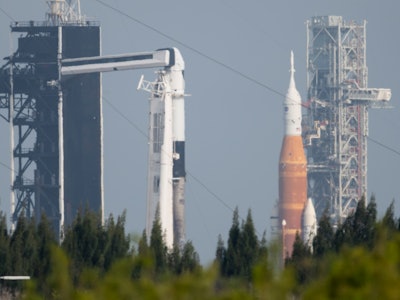NASA wet dress rehearsal woes set back launch date of Moon mega-rocket
The earliest possible flight of the Space Launch System rocket is in mid-summer.

NASA announced on Thursday that it would delay the launch of its new Moon rocket by at least three months, delivering a setback to its ambitious plans to return human boots to the Moon and possibly pave the way for permanent settlement.
The space agency is now hoping to fly its Artemis-1 mission — an uncrewed Orion capsule and a powerful Space Launch System rocket — beyond the Moon and back in early August 2022, much later than the April or May launch dates it was considering back in February.
“As we’ve been saying, we’ll set that official launch date after we get through wet dress,” Jim Free, associate administrator of the Exploration Systems Development Mission Directorate at NASA Headquarters, said during a Thursday media conference call.
The wet dress rehearsal is the final major ground test of the Space Launch System (SLS) rocket, the workhorse of NASA’s Artemis program. NASA personnel detected errors the last three times that this multi-day test was performed in April at a launchpad at NASA’s Kennedy Space Center (KSC) in Cape Canaveral, Florida. Some issues were reparable at the launchpad. But the ones most recently spotted could only be fixed by wheeling the rocket back to the complex’s titanic Vehicle Assembly Building (VAB).
The SLS rocket first rolled out of Kennedy Space Center’s Vehicle Assembly Building on March 17.
The teams working on SLS, which stands taller than the Statue of Liberty, replaced a faulty piece of hardware called a check valve. They are still investigating a leaky fuel cable called an umbilical, which connects it to the frame support of the rocket known as the mobile launcher.
Over the weekend, NASA’s United Launch Alliance partner replaced the check valve. “We’re planning on testing the newly-installed valve later this week if we get to a resolution on that root cause,” said Cliff Lanham, senior vehicle operations manager for NASA’s Exploration Ground Systems Program at KSC.
The culprit so far is a small piece of rubber, which may have triggered the valve’s malfunction sensor and prevented it from sealing correctly, Free said. The check valve erroneously allowed a backflow of helium during the wet dress rehearsal. Teams use the gas for “purging the engine” before fuel is loaded into the rocket tank.
The SLS rocket standing at NASA’s Kennedy Space Center on March 17.
Teams chose to assess several umbilical lines with similar designs to the leaky one, called the tail-service mast umbilical.
They think some loosened bolts may have been the problem, and so far, room-temperature testing shows that the team may have resolved the issue. “We feel like we’ve done what we can do at this point,” Lanham said.
“The next test will be when we flow cryos out on the launchpad,” he said, referring to the ultra-frigid temperatures of the propellant that would catapult Artemis 1 around the Moon.
What’s next — NASA may roll the mission rocket back to its launchpad on May 11, according to Lanham and Free. The agency is targeting a mid-May to early-June redo for the wet dress rehearsal.
Teams want to conduct two more wet dress rehearsals on SLS before considering flight, making August the earliest launch window feasible. Both said they would have to work around the launch of another major NASA mission, Psyche, before landing on an exact date that month.
It’s not yet clear how Artemis 1’s delay will affect its successors, which are the crewed Artemis 2 mission and the lunar-landing Artemis 3 flight. Artemis 2 was scheduled for about two years after Artemis 1, so it’s possible that Artemis 2’s May 2024 target for launch will also be delayed.